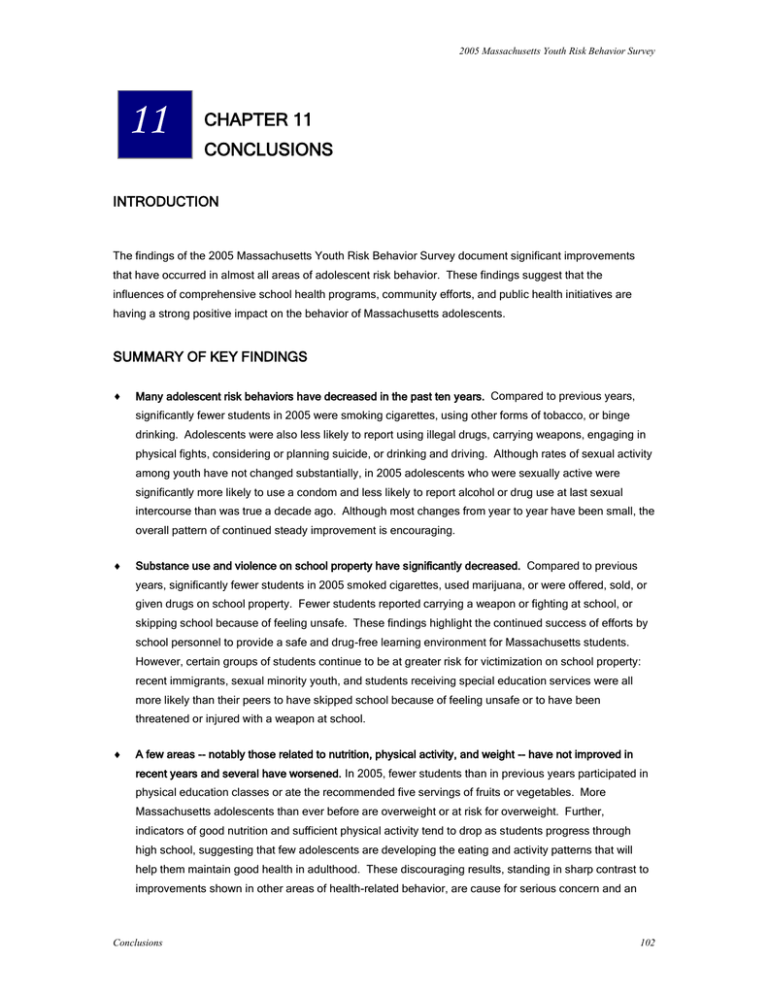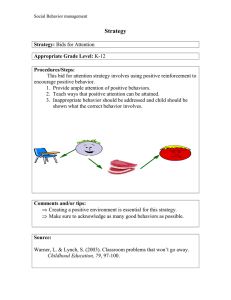
2005 Massachusetts Youth Risk Behavior Survey
11
CHAPTER 11
CONCLUSIONS
INTRODUCTION
The findings of the 2005 Massachusetts Youth Risk Behavior Survey document significant improvements
that have occurred in almost all areas of adolescent risk behavior. These findings suggest that the
influences of comprehensive school health programs, community efforts, and public health initiatives are
having a strong positive impact on the behavior of Massachusetts adolescents.
SUMMARY OF KEY FINDINGS
Many adolescent risk behaviors have decreased in the past ten years. Compared to previous years,
significantly fewer students in 2005 were smoking cigarettes, using other forms of tobacco, or binge
drinking. Adolescents were also less likely to report using illegal drugs, carrying weapons, engaging in
physical fights, considering or planning suicide, or drinking and driving. Although rates of sexual activity
among youth have not changed substantially, in 2005 adolescents who were sexually active were
significantly more likely to use a condom and less likely to report alcohol or drug use at last sexual
intercourse than was true a decade ago. Although most changes from year to year have been small, the
overall pattern of continued steady improvement is encouraging.
Substance use and violence on school property have significantly decreased. Compared to previous
years, significantly fewer students in 2005 smoked cigarettes, used marijuana, or were offered, sold, or
given drugs on school property. Fewer students reported carrying a weapon or fighting at school, or
skipping school because of feeling unsafe. These findings highlight the continued success of efforts by
school personnel to provide a safe and drug-free learning environment for Massachusetts students.
However, certain groups of students continue to be at greater risk for victimization on school property:
recent immigrants, sexual minority youth, and students receiving special education services were all
more likely than their peers to have skipped school because of feeling unsafe or to have been
threatened or injured with a weapon at school.
A few areas -- notably those related to nutrition, physical activity, and weight -- have not improved in
recent years and several have worsened. In 2005, fewer students than in previous years participated in
physical education classes or ate the recommended five servings of fruits or vegetables. More
Massachusetts adolescents than ever before are overweight or at risk for overweight. Further,
indicators of good nutrition and sufficient physical activity tend to drop as students progress through
high school, suggesting that few adolescents are developing the eating and activity patterns that will
help them maintain good health in adulthood. These discouraging results, standing in sharp contrast to
improvements shown in other areas of health-related behavior, are cause for serious concern and an
Conclusions
102
2005 Massachusetts Youth Risk Behavior Survey
indication that the much-publicized “epidemic of obesity” is a serious problem in Massachusetts as it is
in the country as a whole.
Schools need to strengthen their efforts to address this problem, not only by
improving nutrition education and physical education, but also by making good nutrition and activity
prominent features of the school environment.
Risk behaviors tend to cluster together. As can be seen in each chapter, students who engage in one
high-risk or health-compromising behavior are often likely to engage in other risk behaviors as well.
This suggests that a comprehensive approach to health education, rather than programs targeting
specific risk behaviors in isolation, is most appropriate.
Risk behaviors are associated with lower academic achievement. A student who is pregnant or feels
unsafe at school or is depressed is not likely to perform well in school. Indeed, the 2005 MYRBS results
document an association between all categories of risk behaviors and lower academic achievement.
Certain factors in a student’s life have been identified as having a protective effect on behavior.
Students who feel they can talk to a parent or other adult family member, or a teacher or other adult in
school, were less likely than their peers to be participating in some health-risk behaviors. Volunteer or
community service work and participation in extracurricular activities were also associated with lower
levels of many risk behaviors.
For some students, risk behaviors began well before high school. Although the MYRBS surveyed only
high school students, it is clear that a minority began substance use and sexual activity before they
reached the 9th grade. It is important that comprehensive health education and prevention programs
begin in elementary school and continue throughout the middle and high school years.
Patterns of risk are different for different students. Certain groups of students appear to be at greater
risk for health and academic problems because of higher rates of risk behaviors. Gender, race/ethnicity,
grade level, sexual orientation, kind of community, and many other factors were all related to variations
in risk behavior. Although all students need the knowledge, encouragement, and skills to develop
healthy lifestyles, it may also be appropriate to develop “targeted” programs aimed specifically at the
risks faced by certain segments of the adolescent population.
AIDS education is working. Students who were taught in school about HIV/AIDS prevention had lower
levels of some sexual risk behaviors than those who were not. These students were also less likely to
have ever been pregnant or to have ever been diagnosed with a sexually transmitted disease.
CONCLUSIONS
The 2005 MYRBS results highlight continued and significant progress in reducing adolescent risk behaviors
in the Commonwealth. For the most part, this pattern of improvement in nearly all risk categories began in
1995, two years after the beginning of the distribution of Health Protection Funds, which provided financial
support for comprehensive health education in schools. The significant improvements evident in the 2005
MYRBS represent nearly a decade of effective health education and school health programs. However, the
Conclusions
103
2005 Massachusetts Youth Risk Behavior Survey
funds to support these programs were eliminated in 2002, and the full impact of the cuts still remains to be
seen. Many school districts have had to scale back or eliminate health programs, classes, or staff positions
due to budget constraints. Increases in risk behaviors might be expected over time as students are exposed
to less health education and programming.
Continued emphasis on the importance of health and the role it plays in a student’s academic performance is
imperative to sustain the positive momentum of the past ten years. Comprehensive school health education
and human services programs, especially those that help students develop the skills and attitudes needed
for making sound decisions about health and safety, can have a positive effect on adolescent behavior and
prevent those risk behaviors that can act as barriers to student learning.
Further, schools should strive to foster a healthy school environment in which all students feel safe and
connected to the school. The 2005 MYRBS findings suggest that if students have the opportunity to develop
strong relationships with teachers, administrators, and other school staff, and to get involved in community
service work or organized extra-curricular activities, they may be less likely to participate in health-risk or
health-compromising behaviors.
The 2005 MYRBS results highlight continued progress in reducing adolescent risk behaviors in the
Commonwealth. Nevertheless, existing levels of some risk behaviors among Massachusetts high school
youth and the lack of improvement in behaviors related to wellness warrant concern. Comprehensive health
education, coordinated with other school health programs and carried out within the context of a safe and
healthy school environment, can reinforce positive decision-making and behavior change, help youth resist
participation in high-risk activities, and give them the skills they need for a healthy adulthood.
Conclusions
104



